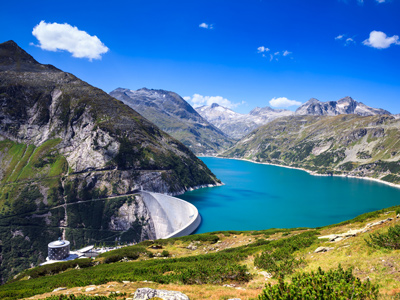Hydroelectric power is a topic that you study in relation to several sections of your geography high school syllabus and also in different subjects, for example science. You need to know about it in the context of land use (e.g. how we use fold mountains), renewable energy sources and also the hydrological cycle (e.g. dam building). It is useful to know and understand the factors that influence the siting of hydroelectric power plants and the conflicts these schemes create as well as the basics of how it works.
Hydroelectric power generates electricity from flowing water. The energy it produces is clean, in other words, no waste materials, greenhouse gasses or other pollutants are produced as the electricity is generated. It is possible to generate small amounts of electricity from the water flowing along a river or stream, however, commercial power plants work by storing water behind a dam in a reservoir.
Water flows through large turbines which contain blades connected to a central shaft that is also connected to a generator. The movement of the shaft is used in the generator to generate electricity.
Dams are built for several different reasons. Some are built as a hard engineering option to manage river flow, reducing flooding downstream. The inclusion of a hydroelectric plant is a secondary concern. Water is held back by the dam and released in a controlled manner. This can ensure a steady flow of water throughout the year rather than the usual seasonal variations. Other dams are built to provide water supplies for cities and some are built with the single idea of generating hydroelectric power. Quite often, the reservoirs and surrounding areas are used for leisure activities like sailing and hiking.
Building a dam for even a small hydroelectric scheme is usually very expensive and can take many years. Before building begins, the best location for the dam needs to be researched and there must be at least one public enquiry as many people will be affected. At the enquiry, each interest group presents their case. When a dam is constructed, land must be drowned. This land is usually being farmed and may also contain woodlands and in some cases, farmhouses and communities like hamlets or even whole villages will be covered by the water. It is important that the needs of everyone, including the flora and fauna, are taken into account. Although hydroelectric power is clean and renewable, it still has an effect on the environment. Hydroelectric power stations need to be built on a huge scale (like the Three Gorges Dam in China) if they are to generate similar amounts of electricity to conventional methods.
Dams for hydroelectric power are usually built in the upper course of rivers. The valleys are narrower so the dams are not as wide, cutting construction costs. There is usually more rain which ensures that electricity production is at a maximum. In fold mountains, e.g. the Yuncan dam in the Peruvian Andes, melting snow can provide most of the water. The disadvantage of that is that production will be reduced during the winter.








